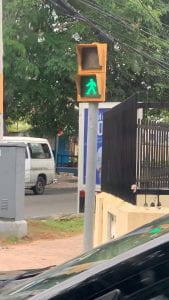Living in the Dominican Republic means you must be able to have excellent coordination when crossing the street. I have been in the DR for four days, and I almost got hit by a car twice. But I live another day to blog about it!
Most of us are accustomed to seeing the familiar red and blue lights behind us as we get pulled over for a traffic violation. A police officer will approach your vehicle and say, “Ma’am, do you know why I pulled you over today?” But in the Dominican Republic, this is not so much the case. I have seen a few police cars driving amongst the traffic in the capital of DR, Santo Domingo. So I wonder who is enforcing these traffic laws. According to Dr. Pichardo, there is no one to enforce laws. Dominicans have similar traffic laws in comparison to the United States. They have yield signs, stop signs, and traffic lights, yet no one follows the regulations.
As we entered the city, we drove along a busy road that had absolutely no traffic lights, road markings or lanes. Everyone seemed to be maneuvering their way through traffic without the need for guidance. Rather than using their turn signals, the driver would stick their hand out of the window to indicate a turn is about to be made. We know this is common for bikers, but even drivers in cars would do this. When driving on the streets of Santo Domingo, one must be aggressive. This is not optional. Otherwise, drivers will not let you merge, and some will not yield. This is similar to home in some ways. Drivers in Atlanta would rather see you die than let you merge. Most cars here are stick shift making it harder to drive on the roads. In addition, the majority of cars have lower than 15% window tint.
The road conditions are poor here. You must be cautious of animals in the streets, missing sewer covers, large potholes, low curbs, and especially pedestrians. Pedestrians do not have the right-of-way here, but many will jaywalk. In locations where there are no crosswalks, pedestrians have no choice, and this can be very dangerous. While driving into the city, I witnessed an accident between a pedestrian and a motorcyclist. There was a policeman that happened to be nearby when the accident occurred, but no information was exchanged, no citations were given, and the pedestrian simply got up and walked away as if she was never hit!
Many Dominicans have a motorcycle, or motoconcho, instead of a car. A motorcycle allows for the driver to zig-zag through traffic. But motorcyclists are primarily at risk for serious injury in the event of an accident. In fact, most road fatalities include cyclists. There are no safety precautions when riding a bike. It is not uncommon to see multiple riders on one motorcycle without a helmet. I often see up to three. On one occasion, I saw a woman holding on the back of the driver with her six-month-year-old child sandwiched in between them.
One solution to the chaos would be public transportation. A ticket for metro can be purchased for just 25 pesos, but unfortunately, many people don’t want to use it. According to our Spanish workshop instructor, citizens buy cars even when they don’t need them. Similar to purchasing flashy jewelry to show off that you “have it made” when in reality, you have not. The streets of Santo Domingo are already overpopulated as is, yet citizens are not bothered by the traffic.
Seeing this country without traffic laws made me reflect on some of our own. In comparison, when there are poorly managed roads, they generally get repaired. While traveling through the Dominican Republic, be mindful of the traffic, including when entering or exiting vehicles on the streets. Try and always cross in the available crosswalks, and only cross when clear to do so. I am praying no major medical emergencies to happen to me while in DR because drivers will not yield for ambulances. Someone could be bleeding to death in the back of the truck as they drive 20 mph through traffic. Crossing the street in the Dominican Republic has become like a mini sport. We’re all just winging it!




When I think about how traffic safety is a public health issue, I typically only focus on seat belt laws, impaired or distracted driving, car seats for children, etc. But your post reminded me just how much road traffic crashes and road traffic injuries are public health issues, too. Thank you for this post and that reminder! While some of our issues in Atlanta aren’t as extreme as you’ve described there in the Dominican Republic, others are the same in both cities. Often on the downtown GSU campus, I see pedestrians dangerously bolt in front of cars, and cars reluctant to slow down or yield in the pedestrian-heavy campus area. I wonder how students, staff, and faculty in the GSU School of Public Health can improve traffic safety around our GSU campus(es)? Any ideas?
Hi Lindy, thanks for responding.
Unlike in the Dominican Republic, we do enforce traffic laws. The city could make an investment to install more speed bumps throughout our campus. Maybe adding more speedometers can bring attention to your speed. Studies show that speedometers do increase drivers’ awareness. In addition, we should ensure that streets remain well lit and that cross walks and lane markers are clear. Pedestrians should not jaywalk or jump in front of cars under any circumstance. It’s important for students to know that arriving to class safely is in the best interest of ourselves and our professors!